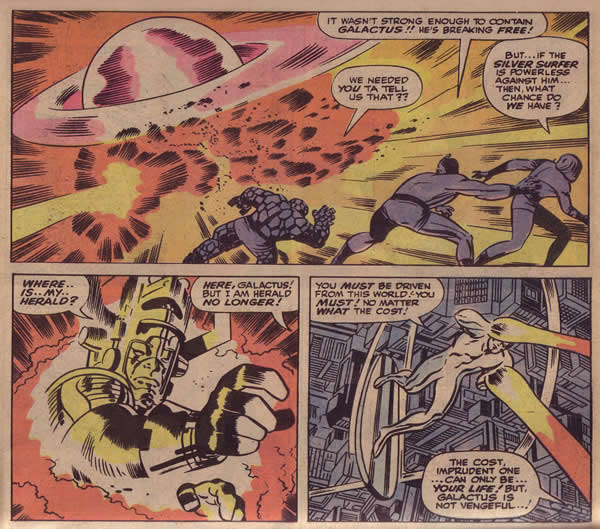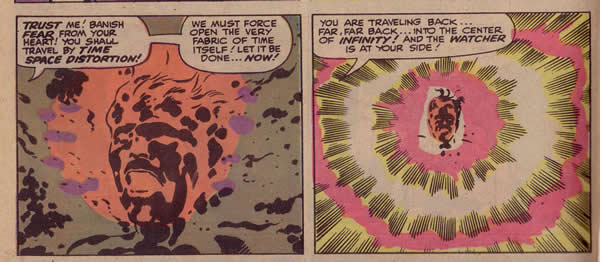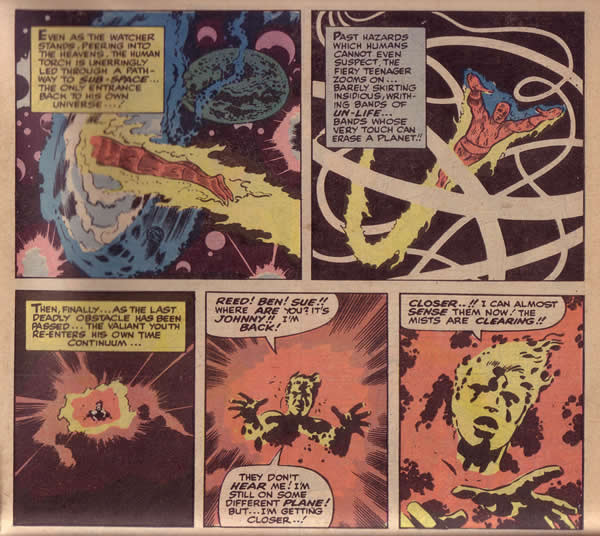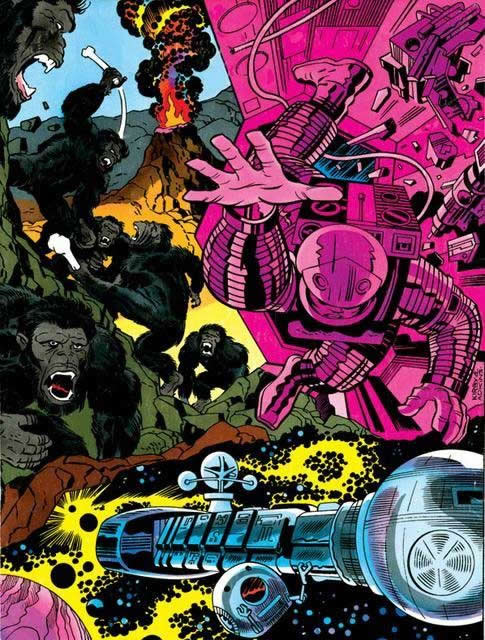If I had to come up with of two words that embodied the sixties, they would be ‘Cosmic Consciousness’. Kirby and Lee’s Fantastic Four, conceived in 1961 at the dawn of the space race, certainly shared in that zeitgeist, but actually ended up in the forefront of the Cosmic movement. The Fantastic Four began their adventures by attempting to journey into space, but, altered by Cosmic Rays they brought space back to earth with them. The team continued to explore intergalactic sci-fi themes in its early years. An intriguing character known as the Watcher was introduced. This benevolent huge headed creature was from a race of beings that could only observe and not interfere. Kirby and Lee toyed with various conventionally villainous bug eyed aliens before bringing us a creature that was so far off the scope of power that he was like unto a god.
Galactus, monstrous consumer of planets was so awesome that the cover announcing his appearance did not even feature him. The cover of Fantastic Four #48, dated May, 1966, showed the shock and awe of our heroes as the Watcher pointed upwards at approaching doom. We could only imagine what could inspire such trepidation.
The story begins in the completion of the previous issue’s tale, as the FF attempt to return to normal life after their encounter with the Inhumans in their Great Refuge. This is not to be. The doorway to weirdness has opened and there is no going back. A small panel at the bottom left of page 7 opens a window to the vista of the infinite cosmos. This is followed by our first view of the Silver Surfer as he zooms towards earth. The camera does not linger. It changes Point of View again to another observer, as the speed trail of the Surfer’s board leads our eye to the nefarious Skrulls who are watching the herald’s approach with dread.
This attitude of looking up in awe characterizes many of the images in the first part of the trilogy, until in the final panel, it is we who are staring up at the looming figure of Galactus himself. The first book is essentially about the fearful anticipation of the arrival of a force beyond comprehension, and the visuals underline this.
Cosmic energy is a force that can barely be conceived by the human mind. In attempting to depict it, Kirby draws upon a palette of visual shorthand devices that he has invented specifically for the occasion. When the Silver Surfer turns upon his master and encases him in a cocoon, Galactus bursts out with a blast of explosive light emanating from a spinning Saturn-like shape that sends our heroes reeling. Kirby’s lines delineate speed and concussion. We can literally feel the force as the figures are driven away from the maelstrom.
The Thing is closest to the blast and is knocked sideways. Reed Richards lunges back, pushing Sue out of the way and shielding her from harm. As the story continues, in order to defeat Galactus, the Watcher must send young Johnny Storm, the Human Torch through a space warp in order to retrieve a weapon.
This story is published in early 1966. Even given Lee’s and particularly Kirby’s propensity for presenting cutting edge social developments, what follows can still be seen as revolutionary. As a representative of youth culture, The Torch’s journey can easily be seen as a mind altering psychedelic trip. Kirby is inventing new symbolism for things that prior to this tale have little solid visual reference to draw from. Kirby graphically illustrates the mind numbing energy that Johnny is absorbing by the black spotting across the planes of his face.
In the pages of this saga, we see a sudden profusion of what will become known as Kirby Krackle. The King has toyed with this effect intermittently prior to this series, but it is in the Galactus trilogy that it occurs in profusion. One begins to notice it in the introductory shots of the Surfer. Kirby is exploring and depicting the interstellar environment more clearly than he has done before, and the Krackle is his ultimate original special effect.
When Johnny returns through sub-space to his own space-time continuum, he must pass through an inter-dimensional pathway. His flame trail weaves through swirling bands of un-life and he remerges in his own dimension amidst a halo of Kirby Krackle, his mind seemingly blown by the experience. He has truly attained Cosmic Consciousness.
Kirby saves the most powerful visual for the ending. When Galactus finally acknowledges defeat, he delivers a stern lecture to Earth beings. This vibrant panel is the climax of the series, as Galactus assumes the nature of pure energy. His body pulses with a corona of blinding light, and bands of Kirby Krackle dance around him, heralding the dawn of the Cosmic Era.
After the Galactus trilogy, Comics would never be the same. The depiction of Cosmic energy would become more mundane and certainly less groundbreaking. The Galactus trilogy was a milestone, and what came later would seldom measure up to the original.
It is difficult to know where or how much the Cosmic work of Jack Kirby had any effect on other forms of media. One of the most significant films of the 1960’s was Stanley Kubrick’s 2001, A Space Odyssey, which depicted a species of alien technology impacting the evolution of Homo sapiens. The climax of the film was the spectacular Star Gate segment that showed astronaut Bowman being propelled through space and time at a fantastic velocity. Again, this particular piece of footage was seen as a powerful metaphor for a mind altering drug trip.
As a result, many of the film’s viewers, especially during the film’s first run would come to the theater under chemical influence, or light up joints just prior to the segment.
The film’s pace and special effects might not be considered optimal by today’s standards, but it was in it’s time both a critical and commercial success. It also obviously made a strong impression on Jack Kirby, as he eventually adapted 2001 to a comic book treatment, both in the original film and a subsequent series. In many ways, this feels like the completion of a circle. My feeling is that Kirby’s work was influential and instrumental in the depiction and mapping of the inner reaches of outer space. His visuals and concepts informed the greater culture with the unique perspective of a man having been without and within the farthest borders of consciousness and the limits of the imagination, and his treatment of 2001 seems to be in many ways the fulfillment of that vision.
Image 1-4 – Galactus trilogy, Fantastic Four #48-50 Jack Kirby and Stan Lee from Marvel Treasury Edition #2
Image 5 – Fantastic Four #50 Jack Kirby, Stan Lee from Marvel Masterworks Volume 25
Image 6 – 2001 Treasury Edition Jack Kirby








My six year old nephew is really into comics these days, he had started out with my reading Carl Barks Uncle Scrooge stories when he was five more recently he asked me to read him some early Ditko Spider-Man reprints (his favorite character) and he’s recently started reading my Fantastic Four Marvel Masterworks Vol 5 (Fantastic Four 41-50) that I had laying around just to see what his reaction to Kirby’s art would be, he’s halfway through The Galactus Trilogy so far (on his own) who says kids these days can’t appreciate the classics?